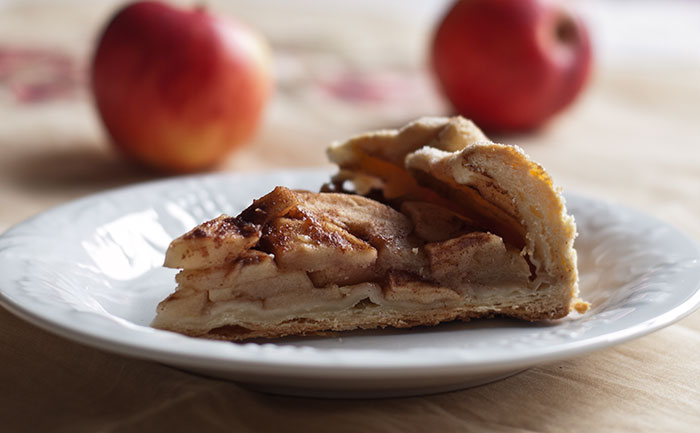
Apple Galette
| Ingredient | 8-inch Galette | 20cm Galette |
|---|---|---|
| Dough | ||
| all-purpose flour | 1½ cup (7½ oz.) | 210g |
| salt | ½ tsp. | ½ tsp. |
| unsalted butter | 10 Tbsp. | 140g |
| ice water | 3-5 Tbsp. | 3-5 Tbsp. |
| sugar | 1 Tbsp. | 1 Tbsp. |
| Fruit Filling | ||
| apples | 1⅓-1½ lb. | 600-700g |
| butter | 2 Tbsp. | 2 Tbsp. |
| raw cane sugar | 2-3 Tbsp. | 2-3 Tbsp. |
| sugar | 1-2 Tbsp. | 1-2 Tbsp. |
| ground cinnamon | ½ tsp. | ½ tsp. |
| Syrup | ||
| water | ⅓ cup | 80 ml |
| sugar | 5 Tbsp. | 5 Tbsp. |
| lemon juice | 1 Tbsp. | 1 Tbsp. |
The rustic, French-style galette is the fruit pie reduced to its proudest essence—nothing but a bit of sugar added to the fruit, and not even a pie tin to get in the way of the buttery, flakey crust. It’s remarkably easy to make for something so flakey, has a hearty, satisfying crunch to go with the delicious fruit, and its rugged good looks will stand out on any table. The addition of dark sugar to the apples adds an additional complexity to the flavor for an even more special treat.
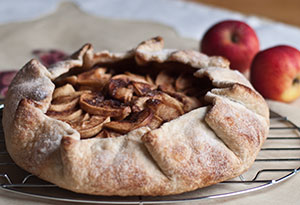
Preparation
- Cut the butter into thin slices and put in the refrigerator to chill.
- Mix the flour and salt in a mixing bowl and put in the refrigerator to chill. Also put the water in the refrigerator.
Directions
- Prepare dough.
- Whisk the chilled flour to fluff it.
- Add the sliced butter, then cut in with a pastry cutter. When the chunks of butter are about pea sized, begin to mix using the sablage method: Scoop up some of the mixture in one hand and rub your other hand across it; the dough should crumble into a parmesan-cheese-like texture. Continue until all the dough is evenly-textured; rub any larger chunks of butter between your fingertips to break them up.
- Make a well in the middle of the mixture and pour 3 tablespoons of ice water into it. Using a bench knife or the sharp edge of a spatula, brush the flour into the water and mix using a cutting motion; don’t stir. Continue mixing until it forms crumbly chunks. If it’s too dry, add a little more ice water.
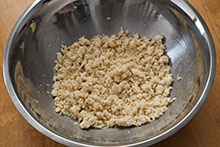
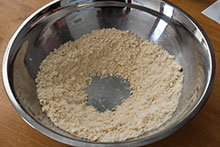
- Turn the dough out onto an un-floured work surface and work it using the frasisage method: Gather it into a long-ish mound and begin smearing the dough away from yourself along the length of the mound, using short strokes, with the heel of your hand. When you’ve worked across all the dough, gather it together again and repeat once.
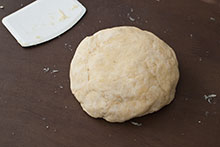 Gather the dough into a ball and cover tightly in plastic wrap, then let rest in the refrigerator for at least an hour, up to overnight.
Gather the dough into a ball and cover tightly in plastic wrap, then let rest in the refrigerator for at least an hour, up to overnight. Dust a work surface with flour. Roll the chilled dough out into a disk about 12 inches (30 cm) in diameter, around ¼-inch (5 mm) thick; work the rolling pin from the inside to the outside. If the dough is too stiff to roll, let it sit at room temperature for 15 minutes or so.
Dust a work surface with flour. Roll the chilled dough out into a disk about 12 inches (30 cm) in diameter, around ¼-inch (5 mm) thick; work the rolling pin from the inside to the outside. If the dough is too stiff to roll, let it sit at room temperature for 15 minutes or so.- Cut a piece of parchment paper to fit a baking sheet, lay the sheet of dough in the middle of it, and refrigerate for 15-30 minutes.
- Prepare fruit filling.
- Peel apples, but do not discard the peels; reserve them in a saucepan. Slice apples in half vertically and cut out and discard the stems and woody bottom bits. Use a mellon baller or knife to remove the cores, again saving them and adding the cores to the saucepan with the peels.
- Slice the halved apples horizontally (across the apple rather than along its axis, like you usually would) into thin slices (about an eighth-inch or 3-4mm).
- In a small microwaveable container melt 2 Tbsp. butter. Mix 2-3 Tbsp. raw cane sugar, 1-2 Tbsp. white sugar, and cinnamon in a small bowl; use more or less sugar depending on the sweetness of the apples.
- Assemble.
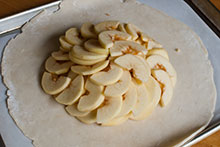 Remove the chilled crust from the refrigerator. Arrange apple slices in the center of the crust in concentric rings, leaving about 2 inches (5 cm) of dough around the edge. Brush melted butter onto the apples, saving a small amount to brush onto the top of the crust. Spread the sugar mixture over the top of the apples.
Remove the chilled crust from the refrigerator. Arrange apple slices in the center of the crust in concentric rings, leaving about 2 inches (5 cm) of dough around the edge. Brush melted butter onto the apples, saving a small amount to brush onto the top of the crust. Spread the sugar mixture over the top of the apples.- Pull the side of the dough up and partway over the fruit one bit at a time, folding it under itself every couple of inches (5 cm) to form pleats; there will be a large opening in the top. If the dough is so stiff that there’s a risk of it cracking while folding it, let it sit at room temperature for about ten minutes first.
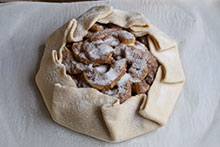 Brush the top of the crust with the remaining butter. Dust the crust with as much of 1 tablespoon of sugar as will stick to it; sprinkle the remaining sugar on top of the apples.
Brush the top of the crust with the remaining butter. Dust the crust with as much of 1 tablespoon of sugar as will stick to it; sprinkle the remaining sugar on top of the apples.
- Bake.
- Bake at 400°F (200°C) on the lower-middle rack for 50-55 minutes.
- Make syrup.
 While the galette is baking, add to the saucepan of apple cores and peels you reserved one third of a cup of water, 5 tablespoons of sugar, and 1 tablespoon of lemon juice.
While the galette is baking, add to the saucepan of apple cores and peels you reserved one third of a cup of water, 5 tablespoons of sugar, and 1 tablespoon of lemon juice.- Simmer for about 25 minutes, until liquid begins to thicken.
- Strain mixture to remove apple remnants, reserving the syrup; it will only be a couple of tablespoons.
- Cool and glaze.
- Put the baking sheet on a cake cooler and let it cool for about 10 minutes. Use the parchment paper to slide the galette off of the baking sheet onto the cake cooler, then slide the parchment paper out from under it and let it finish cooling.
- When the galette has cooled, brush the glaze on top of the exposed apples; leave the crust dry.
- Serve warm or at room temperature.
Notes
- The frasisage method creates an effect similar to puff pastry, but is much easier to do. The smearing motion effectively creates thin sheets of butter between thin sheets of flour that form flaky layers when baked. In the case of a galette like this, with no pan to hold it together, the frasisage shell is less prone to leaking than other types, since you’re less likely to have a glob of butter that will melt and form a hole in the crust.
- If the apples you’re using have red skins, it will color the syrup red, as in the photo above.
- Galettes work with just about any firm fruit, of course; we also have a recipe for peach blueberry galette.
- You can substitute Muscovado sugar for raw cane sugar.

